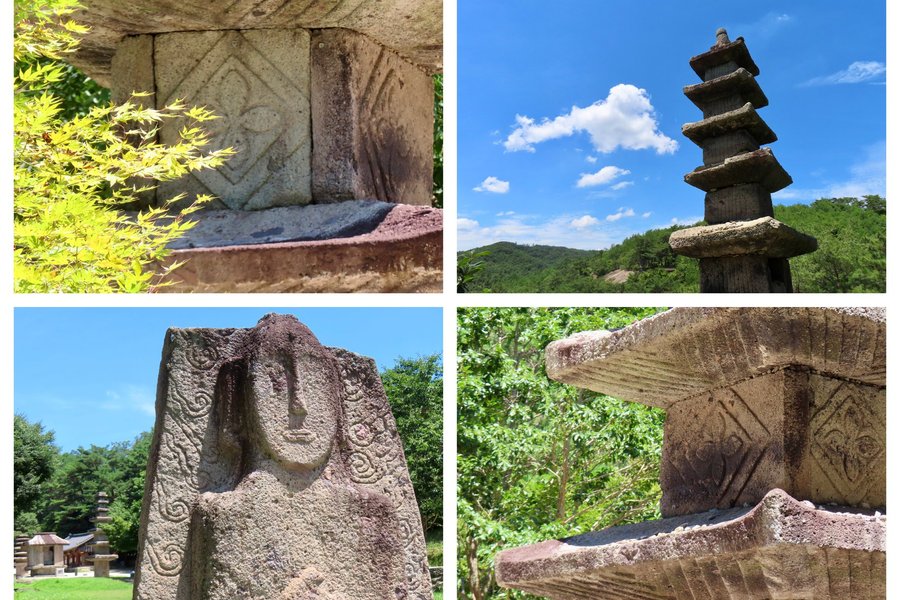CugelVance 1
Unjusa, baffling and enigmatic
Stone Buddhas and Pagodas at Hwasun Unjusa Temple (On tentative list)

Time of the visit:the 24th of oct.,2025
At 10.00 I took the bus 318 from Gwangju 's bus terminal to Unjusa temple where we arrived around 40 min. later.The day before I had taken a photo of the bus 318' s timetable.The aforementioned bus stop is outside the bus terminal, right in front of the terminal's main exit. You have to use Google Lens to understand the timetable, as everything is in Korean. Behind the departure line, it says "Unjusa Temple"... that's the correct bus. The bus stopped 3-4 meters from the Unjusa entrance gate.I asked the guard/receptionist for the timetable for the return trip. The timetable is posted on the outside wall of the reception. She showed me which of the infrequent buses I could take back to Gwangju.
My original intention was to stay until 4/5 p.m., but on the outbound trip, the bus passed the Hwasun Dolmen Complex(Unesco site) where the annual Dolmen Festival( every octobre) was taking place. So I changed my plans and wanted to take the 1:38 p.m. bus back to get off there..
As for the Unjusa temple it is a historic Buddhist temple located in Hwasun County, about 26 kilometers southwest of Gwangju, South Korea. It is famous for its mysterious collection of hundreds of stone Buddha statues and pagodas scattered across the hillside. According to legend, the temple was founded during the late Silla Dynasty by the monk Doseon, who planned to build a thousand Buddha statues and pagodas to bring balance to the Korean peninsula.
Today, Unjusa is often called “the Temple of a Thousand Buddhas”-one should not take this too literally- and is known for its unique stone art, serene natural surroundings, and spiritual atmosphere. It remains one of Korea’s most intriguing and culturally significant temple sites.
Essentially, there's a main path, from which paths branch off to the right and left, leading upwards. The main path leads to the temple complex, which isn't that large and consists only of a few sub-temples. The rear part of the main complex consists of living quarters for the monks, closed to visitors. The temples are impressive, but not as magnificent as those in Tongdosa. Personally, I found the exterior of the temples more interesting than the interior.Afterward, I explored all the paths leading up to the left and right. The strange fascination of Unjusa Temple lies in its unusual pagodas and Buddha figures.According to an information board – all of which are in Korean and English – the temple has 21 pagodas and around 100 Buddha statues placed in different parts of the temple complex. There are seated,standing,and reclining Buddhas..two Buddhas with their backs touching one another,Buddhas carved in relief and natural stone walls.Very unusual.The same goes for the stone pagodas...very unusual..they are characterized by diverse and unconventional shapes.There are 3,5,7 and 9 storey pagodas.The surface of the pagodas has various engravings of geometrical patters which have never been found anywhere else around the globe.One theory claims thst the Mongolians influenced that unique design..pure speculation.The magic of the Unjusa Temple lies in its Buddha statues and pagodas... definitely not in its temple buildings.My thumps go up.
A recommendation and a warning
⚠️I was waiting for my 1:38 p.m. bus at the bus stop... The elderly lady hurried out of her entrance booth and told me that the timetable was no longer up to date.The elderly lady, a Japanese woman married to a Korean man and living in Korea for over 30 years, invited me into her car and drove me to the main street, whose stop is also served by bus 228.I was unlucky. The older Japanese woman went into the cafe right next to the bus stop asking when the next bus was leaving, as she didn't understand the bus schedule either. It turned out I had missed the bus by a few minutes. I had to wait until 2:30 for the next bus. I sat down in the cafe and bought a coffee and a snack. The friendly owner alerted me a few minutes before the arrival of the next bus.So make sure you know the exact departure time of your desired bus from the Unjusa temple.If you missed it,just walk around 10-15 min. to the main street.The bus 218 also goes back to Gwangju....and is far more frequent that the bus 318.The timetable in Gwangju is correct.
A recommodation: Gwangju is a great and very pleasant city which deserves one or two nights. It offers wonderful presents to its visitor like the Daein market full with delicious food,art and music, the Asia Center area,or the Christian quarter of Yangnim with its churches,galleries,cafes and bakeries,Japanese bunkers and its hilarious Penguin village.
If you have time to see only one attraction in Gwangju ,head to the Sajik park with its observation deck.Your jaw will drop in amazement, breathtaking.The lights go on as soon as it is dark.The whole park is a sea of lights... you feel like you are in a fairytale world... magical... enchanting.
Comments
No comments yet.
